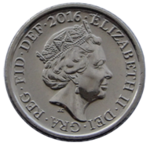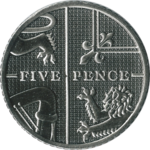United Kingdom | |
| Value | £0.05 |
|---|---|
| Mass | (1968–1990) 5.65 g (1990–present) 3.25 g |
| Diameter | (1968–1990) 23.59 mm (1990–present) 18.00 mm |
| Thickness | (Cupro-nickel) 1.7 mm (Steel) 1.89 mm |
| Edge | Milled |
| Composition | Cupronickel (1968–2010) Nickel-plated steel (2011–) |
| Years of minting | 1968–present |
| Obverse | |
 | |
| Design | Queen Elizabeth II |
| Designer | Jody Clark |
| Design date | 2015 |
| Reverse | |
 | |
| Design | Segment of the Royal Shield |
| Designer | Matthew Dent |
| Design date | 2008 |
The British decimal five pence coin (often shortened to 5p in writing and speech) is a denomination of sterling coinage worth 5⁄100 of a pound. Its obverse has featured the profile of Queen Elizabeth II since the coin’s introduction on 23 April 1968, replacing the shilling in preparation for decimalisation in 1971.[1] It remained the same size as the one shilling coin, which also remained legal tender, until a smaller version was introduced in June 1990 with the older coins being withdrawn on 31 December 1990.[2] Four different portraits of the Queen have been used, with the latest design by Jody Clark being introduced in 2015. The second and current reverse, featuring a segment of the Royal Shield, was introduced in 2008.
5p coins are legal tender up to the sum of £5 when offered in repayment of a debt; however, the coin's legal tender status is not normally relevant for everyday transactions.[3]
The five pence coin was originally minted from cupro-nickel (75% Cu, 25% Ni), but since 2011[4] it has been minted in nickel-plated steel due to the increasing price of metal. From January 2013, the Royal Mint began a programme to gradually remove the previous cupro-nickel coins from circulation with replacement by the nickel-plated steel versions.[5]
In March 2014, an estimated 3,847 million 5p coins were in circulation with an estimated face value of £192.370 million.[6]
- ^ Bignell, C P. "Post decimalisation". Archived from the original on 23 June 2012. Retrieved 23 May 2006.
- ^ Stephen Eckett; Craig Pearce (2008). Harriman's Money Miscellany: A Collection of Financial Facts and Corporate Curiosities. Harriman House Limited. p. 19. ISBN 978-1-905641-95-6.
- ^ Royal Mint Frequently Asked Questions Archived 8 January 2009 at the Wayback Machine
- ^ Decimal Five Pence Archived 26 September 2017 at the Wayback Machine | author=Tony Clayton
- ^ "Cupro Nickel Replacement Programme". Royal Mint. 2013. Archived from the original on 30 March 2013. Retrieved 24 February 2013.
- ^ "Mintage Figures". Royal Mint. Archived from the original on 17 May 2013. Retrieved 28 December 2015.